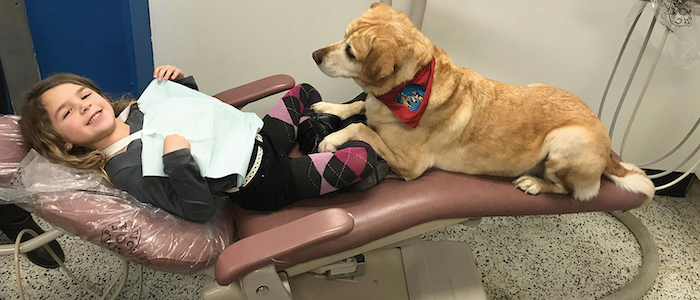lens
Four-Legged Support
Exploring the benefits of interactions between humans and therapy animals
 PHOTO: Courtesy of Aviva Vincent
PHOTO: Courtesy of Aviva VincentResearchers teamed up with the Pet Therapy Program at University Hospitals Cleveland Medical Center to bring certified, trained dogs to dental appointments.
For decades, researchers have known that dogs and other animals help reduce our stress. But what's going on in the human body to produce the calmer state?
Case Western Reserve's Aviva Vincent, PhD (GRS '19, social welfare), is working on answers by tracking human stress and relaxation levels when a therapy animal is present.
"Being able to quantifiably measure these physiological changes, especially positive indicators rather than stress, from a human-animal interaction, is a huge step in advancing the field," said Vincent, an adjunct faculty member at the Jack, Joseph and Morton Mandel School of Applied Social Sciences.
Vincent's specialty—veterinary social work—is an emerging field in which practitioners work with therapy animals to help people.
Last year, Vincent, along with colleagues from the university's School of Dental Medicine, conducted a pilot study to assess the impact of therapy dogs on 18 children with known dental fears and anxiety. The team collected saliva samples to measure cortisol and alpha-amylase—span> both stress indicators—and oxytocin, a hormone indicating a relaxation response.
While the study was small, the saliva analysis supported reports from all the parents and children that the therapy dogs reduced stress during the appointments. Vincent is planning a similar study with 130 children.
In addition, she is studying the stress and relaxation levels of more than 70 individuals —many of whom have challenges such as post-traumatic stress disorder or an autism-spectrum disorder—as they interact with horses at the Fieldstone Farm Therapeutic Riding Center in Chagrin Falls, Ohio, where she's also the center's director of program quality.





